Home >> Electricity, power & energy
energy |
Energy
To understand how energy is converted consider a simple circuit with a 'load' * resistor and a D.C. source.
* this could be a heater element, a motor or indeed any component with resistance

Charge loses potential energy(PE) as it moves through the resistor. This electrical PE is transformed mostly into heat energy dissipated in the resistor.
The PE is defined as*:
work = charge x potential difference
W = QV
(Joules) = (Coulombs) x (Volts)
*for more information on this equation see the definition of the volt
Since,
charge = (current) x (time current flows)
Q = It
(Coulombs) = (Amps) x (seconds)
therefore, substituting for Q in the work equation,
W = (It)V
rearranging,
W = VIt
Power
By definition, 'power' is the rate of working and is equal to the work done divided by the time taken.
![]()
substituting for W
![]()
cancelling the 't'
![]()
(Watts) = (Volts) x (Amps)
note: 1 Watt is a rate of working of 1 Joule per second.
The equation for power can be modified if we make substitutions using Ohm's Law.

substituting in the power equation for V ,

substituting in the power equation for I,

The Kilowatt-hour (kWh)
A kilowatt-hour is a unit of energy.
By definition, a kilo-watt hour is the amount of energy consumed when a 'rate of working' (power) of 1 kilowatt is used for 1 hour.
conversion of 1 kWh to Joules:
1 kWh = 1 kW x 1 h = 1000 W x 3600 s = 3600000 J
1 kWh = 3.6 x 106 J
Energy for direct current(D.C) & alternating current (A.C.)
Direct current does not vary with time and it is always in one direction.
On a plot of power against time, D.C. is a horizontal line.
The area under the plot gives the total work done/energy used.
This is simply the product of the constant power( Pconst.)and the time interval that the power is used for( t' ) .
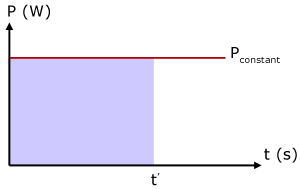
![]()
However, for A.C. the situation is more complex.
Here not only does the current value vary, but its direction varies too.
The power through the resistor is given by:
![]()
But we must take the average of this power over time 't' to calculate the energy/work.
So the energy/work done is given by,
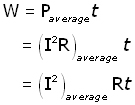
The Root Mean Square ( RMS) current is defined as:
![]()
IRMS is the square root of the average of the current squared.
Therefore energy/work done is given by,
![]()
IRMS is the equivalent D.C. current having the same effect on a resistor as the A.C.
Here is a graph of an A.C. sinusoidal waveform:
![]()
where,
Io is the maximum current |
ω is the angular frequency, ω = 2πf ( π pi , f frequency) |
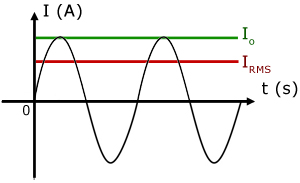

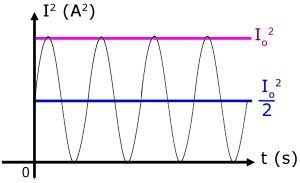
Recalling the A.C. energy/work done equation,
![]()
and substituting for IRMS
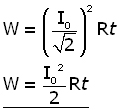
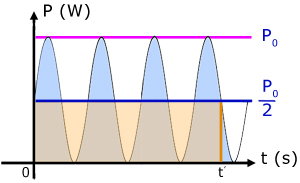
Therefore at time t' the energy W dissipated in resistor R is given by:
![]()
note: to avoid confusion between W in equations and W on the graph
P (W) on the graph means power P in watts. |
W in equations is the energy/work done |
[ About ] [ FAQ ] [ Links ] [ Terms & Conditions ] [ Privacy ] [ Site Map ] [ Contact ]
